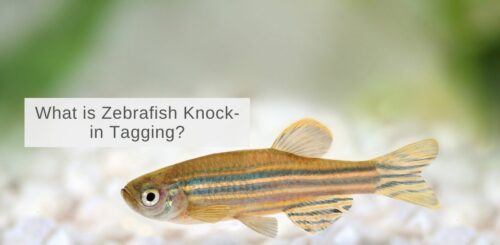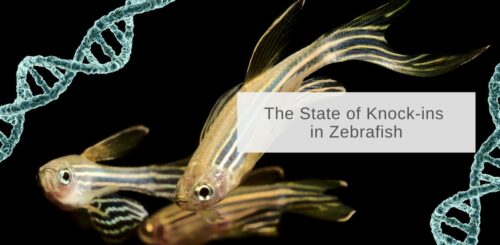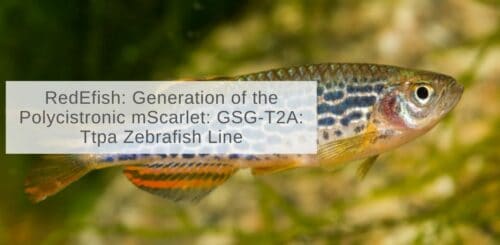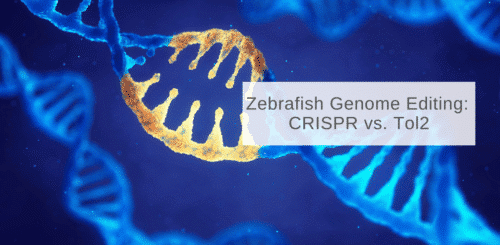Zebrafish Genome Editing
Home > Resources > Zebrafish Resource Center > Zebrafish Genome Editing
Zebrafish Genome Editing
We’ve compiled a collection of articles and reviews that discusses a variety of zebrafish genome editing methodologies, as well as our trials and errors on how to successfully deploy editing techniques.

What is Zebrafish Knock-in Tagging?
While there have been many advancements, zebrafish knock-in (KI) techniques still aren’t fully optimized or understood. In this article, we aim to give a quick summary of the different types of knock-in tagging techniques.

How Does Cre/loxP Recombination Work?
In this blog, we are going to talk about the basics of the Cre/Lox technique which is used in conditionally controlling gene manipulation in zebrafish.

The State of Knock-ins in Zebrafish
The recent advancements of CRISPR and next-generation technology has enabled researchers to create more precise zebrafish models of human disease. This being said, knock-in (KI) techniques in zebrafish still aren’t fully optimized.

Spotlight on InVivo Biosystems’ Zebrafish Work
Recently, the life science operating platform Scispot released its list of the Top 5 Zebrafish CROs in the World, with InVivo Biosystems at the top of the list! Check out some of our recent zebrafish work that helped us earn this title.

RedEfish: Generation of the Polycistronic mScarlet: GSG-T2A: Ttpa Zebrafish Line
In a recent publication, Dr. Tanguay and her lab created a new fluorescent-tagged zebrafish line to study the effects of Vitamin E on embryonic development. This article will give an overview of the Tanguay Lab’s work, and discuss: ‘why zebrafish’?

Zebrafish Genome Editing: CRISPR vs. Tol2
At InVivo Biosystems, we specialize in multiple different ways of zebrafish genome editing such as an insertion, deletion, or replacement of DNA at a specific site in a genome, which allows us use the zebrafish to study detailed characteristics of its human ortholog.

Zebrafish Injection Mix: Buy verses DIY, what are the real costs?
Check out the infographic to learn more about the costs of DIYing your own zebrafish CRISPR project verses working with our team of experts.

6 Key Steps to a Successful Zebrafish Knock-in
Successful zebrafish knock-ins are hard, we are not going to sugar coat it for you, but we at InVivo Biosystems are approaching an 80% success rate in our knock-ins and wanted to share with you what we believe to be the 6 key steps to having a successful knock-in project.

The Challenge of Getting CRISPR-based Knock-ins to Work in Zebrafish
Although there have been literature reports for years, the number of labs that struggle and fail with knock-ins far outweigh the number that find success and publish.

6 things that can go wrong while making your Zebrafish CRISPR Knock-In
We discuss the biggest pitfalls, pain points and precautions our team has encountered at the bench and in the zebrafish community so you can be fully prepared as you embark on your own knock-in odyssey.

Intro to CRISPR: Zebrafish Mutations
Check out this infographic to learn more about the CRISPR mechanisms, zebrafish injections, and the different types of mutations such as gene knockouts, point mutations, precise deletions, and floxed alleles.

What Can Zebrafish Tell us About CRISPR Off-Target Activity?
Zebrafish are emerging as a valuable animal model for CRISPR work, including the determination of off-target effects.

Conditional Mutagenesis by LoxP Insertion in Zebrafish – Outfloxing the Unfloxable
We have overcome the challenge of generating mutant lines by focusing on the screening process, namely in substantial variability in PCR detection of loxP site integration at target loci.

An Abnormal Absence of Antibodies: Filling the Gaps with Gene Editing Tools in Zebrafish
Zebrafish researchers have historically been plagued by a paucity of robust antibodies in zebrafish. One of our zebrafish experts explains why the advent of CRISPR/Cas9-mediated gene editing in zebrafish makes it possible to circumvent this problem.
